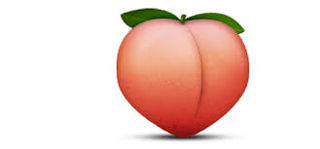President Donald Trump
The Curious Case of the Peach Emoji and the President
Why the "sexy peach" emoji has become the new political symbol
Posted October 3, 2019

A few days ago, I gave an interview to a reporter at The Washington Post. She wanted to know why the peach emoji, a long-time sexting favourite, widely used to designate, how shall we put it nicely, a desirable derrière, had become the latest emojified internet meme. In the curious case of the sexy peach emoji, it has been transformed into a viral symbol of internet resistance, against, for some, a rogue President, subject to a newly-established impeachment inquiry.
While President Trump rages, reaffirming, in a joint presser with the President of Finland, that "There are those that think I’m a very stable genius", that his political opponent Joe Biden is “stone cold crooked”, and labelling much of the American media not just "fake", but also "corrupt", the sexy peach emoji is spreading its orange ripeness across the internet. It stands, today, as America's most unlikely symbol of opposition. You can listen to an audio of the press conference from The Guardian.
Lizzo and the 'im-PEACH-ment' emoji
A case in point is the singer Lizzo, who recently posted, on twitter, the peach emoji as a symbol of impeachment:

The question I was asked was this: why has the peach emoji been re-purposed as a cry for impeachment, and hence a symbol of resistance? The short answer concerns a basic principle of how pictographic systems of communication evolve, known as the Rebus Principle. If you can't make a picture of something abstract, namely impeachment, use a picture of something with the same sound, the sexy peach emoji. Hey presto: one symbol of resistance: a cry to im-PEACH!
The Washington Post published the story: How the sexy peach emoji joined the resistance. The story has even crossed the language barrier. A French-language version appears as: Comment les emoji « sexy à la pêche » ont rejoint la résistance. But the bare bones that were reported are only part of the story. The full explanation involves the ancient Sumerians, the world’s earliest civilisation in the fertile crescent of old Mesoptamia, and Cuneiform the world’s first writing system, which they developed well over 5,000 years ago. And the details are worth spelling out. After all, in the digital age, Lizzo was repurposing a pictogram as a symbol of resistance, using a tried and tested method that has a fair bit of history!
From pictograms to writing
First things first: how does Emoji, a system of pictograms – pictorial glyphs representing a concrete idea – compare to a writing system? Well, in fact, and just like Emoji, the world’s earliest form of writing started out as a pictographic system.
Writing was invented by the Sumerians, around 3,400 BCE. Sumer was the earliest urban civilisation that we know of, dating from around 6500 BCE. It was located in Mesopotamia – the vast region sandwiched between the Euphrates and Tigris river systems – corresponding roughly to large parts of modern-day Iraq, the southern part of Turkey, as well as taking in parts of Syria and Kuwait. Mesopotamia is often dubbed the cradle of civilisation, having given rise to Sumerian, Akkadian, Assyrian, and Babylonian civilisations.
The Sumer writing system, known as cuneiform, was first developed sometime in the middle of the fourth millennium BCE, but continued to evolve for over 3,000 years, before ceasing to be used during the second century BCE. It began as a pictographic system with around 1,000 signs, before developing its characteristic wedge-shaped signs, of around 400 in total.
The diagram below illustrates the development of the cuneiform writing system, showing how the written form of the Sumerian word sag, meaning ‘head’, evolved between 3000 to 1000 BCE.

While in its earliest form, the representation was pictographic, by stage 4, the characteristic wedges were in evidence providing a more abstract means of representing the word. In fact, the word cuneiform that we use to name the Sumerian script derives from the Latin for wedge: cuneus. With the use of wedge shapes, these could be combined to create a wide array of signs to designate concrete ideas as well as more abstract notions.
In the earliest stages of its evolution, cuneiform was a pictographic system: the pictograms at stages 1 (around 3000 BCE) and 2 (around 200 years later), for instance, iconically represent an entire word: the pictogram resembled the entity it represented. But later on, a system of wedge shapes were used to capture the same idea. As such, cuneiform evolved the capacity to use the wedge shapes to capture syllables, and even had the capacity to represent sixteen consonants and four vowel sounds, akin to an alphabet. In so doing, cuneiform evolved from using pictograms to ideograms – abstract visual symbols to represent a given idea.
From Pictograms to ideograms: The Rebus Principle
One of the challenges for a writing system is how to represent more abstract ideas. While pictograms are all well and good, try representing ‘iconoclastic’, feminism’, or indeed ‘impeach’ using pictures. After all, a picture is grounded in something concrete in the world, such as a peach. But the notion of ‘impeachment' is altogether more abstract, relying on an understanding of complex principles and systems of governance, in a particular nation-state context. But just like the singer Lizzo, the inventors of the world’s earliest writing systems struck on the same idea: use the sound associated with a pictorgram to represent the more abstract idea, that happens to share that sound in spoken language. This was the route take by the Sumerians, and indeed the ancient Egyptian’s in developing their writing systems.
Another early writing system, Egyptian hieroglyphs, were primarily pictographic at the outset. They emerged slightly later than cuneiform, and were used to represent ancient spoken Egyptian, known as Coptic, which survives today only as a liturgical language in the Coptic Orthodox Church. The term hieroglyph comes from the ancient Greek: heiros means ‘holy’ and glyphe means ‘writing’, hence ‘holy writing’. Indeed, hieroglyphs were originally developed to honour the gods and the pharaohs – the divine rulers. By the middle of the third millennium BCE, there were around 800 hieroglyphs; by the time they ceased to be used, having been replaced by the later emergence of alphabetic systems in the Greco-Roman period, they numbered around 5,000.
Hieroglyphs functioned originally as pictograms; used in this way they were followed by an upright stroke, to show that an entire word was being symbolised. But the development of hieroglyphs towards the more flexible syllabic and alphabetic types of writing invoked what is known as the Rebus Principle: by which pictograms could also function phonetically.
Essentially, the Rebus Principle allows a message to be produced by the sound associated with a picture, rather than by the picture itself. To show you how this works, consider the following example from medieval heraldry, where it was common to use the sound allusion of pictures on flags and shields to stand for a family name. For instance, the heraldry for Walter Lyhart, Bishop of Norwich from 1446 to 1472, in England, was an image of a stag (hart is an older word for a male deer) lying down. In this way, a pictographic representation of a ‘lying hart’, by virtue of the Rebus Principle, stood for the Lyhart family name.
The Rebus Principle was the way in which hieroglyphs developed in order to enable the pictograms to represent more abstract ideas. For example, the hieroglyph below represented an Egyptian vulture.

If the hieroglyph was followed by an upward stroke, then what was meant was an entire word, hence: vulture. But following the Rebus Principle, the picture could also be used phonetically. The word for Egyptian vulture was pronounced with a glottal stop – similar to the English pronunciation of the two ‘t’s in bottle by a speaker of London Cockney. Without the upward stroke, the hieroglyph was read phonetically, as a glottal stop. In this way, hieroglyphs could be combined in order to write, in principle, any Egyptian word – although hieroglyphs were never fully regularised into a true alphabetic writing system.
So what about Emoji?
In our digital conversations, in text-speak, we often apply the Rebus Principle to use emojis as sounds, as Lizzo did. An example is when the eye emoji is used, not to signal an eye, but rather, the first person singular pronoun: 'I'. For instance, the example here shouldn’t prove too challenging to figure out:

But while the use of the eye emoji in this way represents the first person pronoun, this doesn’t, alas, amount to a truly alphabetic use of an emoji. After all, the Rebus Principle allows the eye emoji to substitute for the English word 'I': an entire word. But an alphabetic writing system, in principle, establishes a one-to-one correspondence between a symbol and a sound. For this reason, Lizzo used alphabetic letters to spell out her message: IM—PEACH—MENT, with the sexy fruit emoji embedded in letters:

But in this way, in the digital age, visuals are being used as a humorous and eye-catching way to enhance the message. They do so by providing what, in The Emoji Code, I dub a visual gestalt, one that, in an instant, and 120.4K likes later, has become a powerful symbol of resistance.
References
Evans, Vyvyan. 2017. The Emoji Code: The Linguistics Behind Smiley Faces and Scaredy Cats. Picador.




